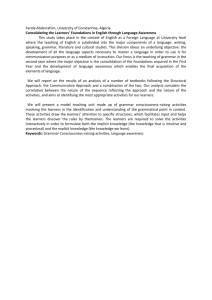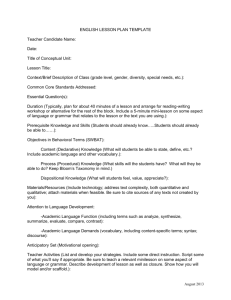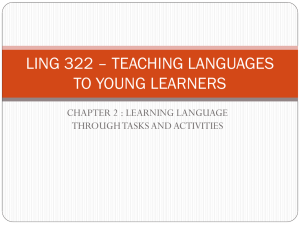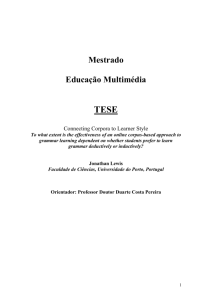TESOL Grammar Teaching Methods: Deductive vs. Inductive
advertisement
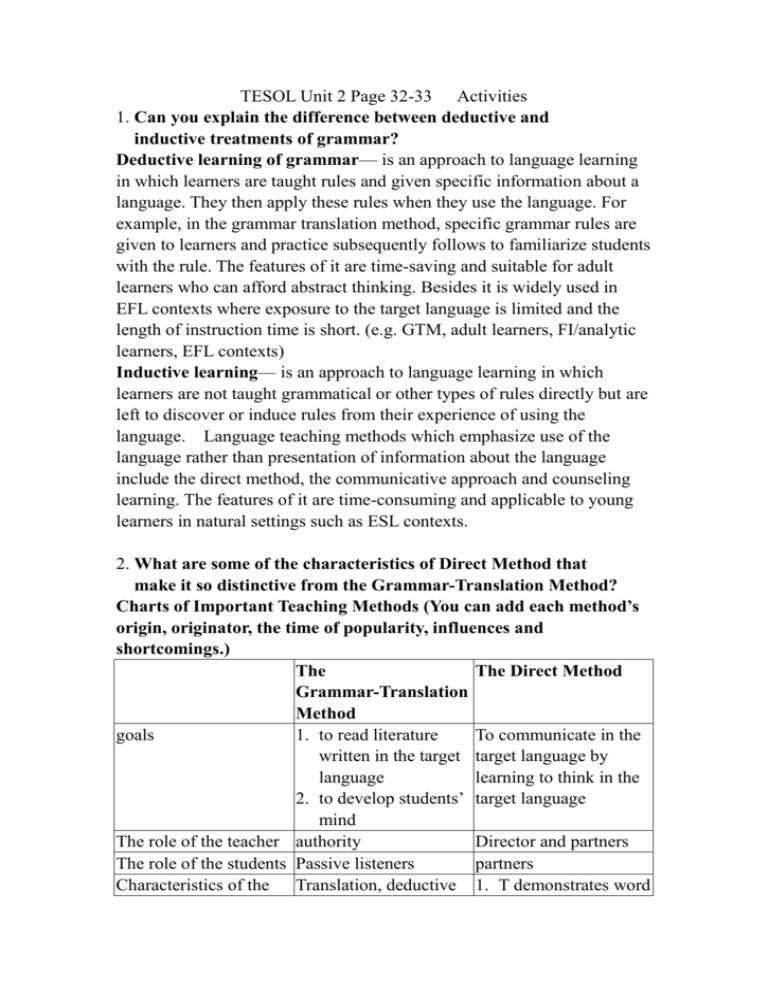
TESOL Unit 2 Page 32-33 Activities 1. Can you explain the difference between deductive and inductive treatments of grammar? Deductive learning of grammar— is an approach to language learning in which learners are taught rules and given specific information about a language. They then apply these rules when they use the language. For example, in the grammar translation method, specific grammar rules are given to learners and practice subsequently follows to familiarize students with the rule. The features of it are time-saving and suitable for adult learners who can afford abstract thinking. Besides it is widely used in EFL contexts where exposure to the target language is limited and the length of instruction time is short. (e.g. GTM, adult learners, FI/analytic learners, EFL contexts) Inductive learning— is an approach to language learning in which learners are not taught grammatical or other types of rules directly but are left to discover or induce rules from their experience of using the language. Language teaching methods which emphasize use of the language rather than presentation of information about the language include the direct method, the communicative approach and counseling learning. The features of it are time-consuming and applicable to young learners in natural settings such as ESL contexts. 2. What are some of the characteristics of Direct Method that make it so distinctive from the Grammar-Translation Method? Charts of Important Teaching Methods (You can add each method’s origin, originator, the time of popularity, influences and shortcomings.) The The Direct Method Grammar-Translation Method goals 1. to read literature To communicate in the written in the target target language by language learning to think in the 2. to develop students’ target language mind The role of the teacher authority Director and partners The role of the students Passive listeners partners Characteristics of the Translation, deductive 1. T demonstrates word teaching/learning processes learning of grammar, memorization of words and equivalents S-T or S-S interaction The feelings of the students View of culture & language Mostly T->S no Emphasis of skills & areas The role of L1 evaluation 1. literary language is superior to spoken language 2. culture consists of literature and fine arts meanings through the use of realia, pictures, or pantomime 2. situation or topic-based syllabus 3. inductive learning of grammar 4. practice vocabulary in complete sentences 5. Ss speak a lot both no 1. language is primarily spoken 2. culture consists of the history of the target culture, the geography of the country, and information about the daily lives of the speakers Reading and writing; 1. vocabulary over vocabulary and grammar grammar 2. pronunciation teaching in the beginning 3. oral communication as basic Mostly used in class for No L1 translation Written tests Oral interviews or (translation) and paragraph writing (not practice of grammatical to demonstrate the rules knowledge about the Error correction techniques T provides the correct answer; the correct answer should be got Translation of a literary passage, reading comprehension questions, antonyms/synonyms, cognates, deductive application of rule, fill-in-the-blanks, memorization, use words in sentences, composition language but how to use the language) Self-correction Reading aloud, question and answer exercise, getting students to self-correct, conversation practice, fill-in-the-blank exercise in the target language, dictation, map drawing, paragraph writing 3. It has been said that it may be advantageous to a teacher using the Direct Method not to know his students’ native language. Do you agree? Why? It depends. The teacher can be a great model for students to learn how to communicate in the target language in everyday life. They will have to use the target language to their teacher without resort to their native language. In language use, it is likely for students to master pronunciation, listening and speaking, etc. On the other hand, the teacher may not be familiar with students’ difficulties in learning the target language. Factors that influence the effectiveness of learning a language include students’ native language. Besides, for beginners especially, the use of their first language sometimes can give them a sense of security. They will not be anxious about not knowing what the teacher means. Some meanings of words or utterances can be easily stated with the use of L1. It can be more time-saving. Therefore, the goal of language learning and the type of learners may be crucial factors when it comes to a teacher using the Direct method.

